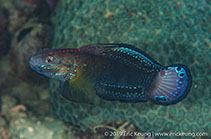Amblygobius phalaena (Valenciennes, 1837)
Whitebarred goby
分類 / Names 俗名 | 同種異名 | Catalog of Fishes(屬, 種) | ITIS | CoL | WoRMS | Cloffa
Teleostei > Gobiiformes (Gobies) 鱸形目 (Gobies) > Gobiidae (Gobies) 鰕虎魚科 (Gobies) > Gobiinae
Etymology: Amblygobius: Greek, amblys = darkness + Latin gobius = gudgeon (Ref. 45335).
More on author: Valenciennes.
Etymology: Amblygobius: Greek, amblys = darkness + Latin gobius = gudgeon (Ref. 45335).
More on author: Valenciennes.
Environment: milieu / climate zone / depth range / distribution range 生態學
海洋 礁區魚類; 深度上下限 ? - 52 m (Ref. 86942), usually 2 - 20 m (Ref. 27115). 熱帶; 22°C - 30°C (Ref. 27115); 30°N - 32°S
分布 國家 | FAO區域 | 生態系 | 發現紀錄 | Point map | 簡介 | Faunafri
Pacific Ocean: Philippines to the Society Islands, north to Ryukyu Islands, south to southern Australia (including Lord Howe Island) and Rapa Island; throughout Micronesia.
太平洋: 菲律賓到社會群島, 北至琉球群島, 南至澳洲 (包括羅得豪島) 南部與拉帕島; 在密克羅尼西亞各處。 被在紅海的 Amblygobius albimaculatus 取代了而且在西印度洋被 Amblygobius semicinctus 取代了。 (參考文獻 37816)
太平洋: 菲律賓到社會群島, 北至琉球群島, 南至澳洲 (包括羅得豪島) 南部與拉帕島; 在密克羅尼西亞各處。 被在紅海的 Amblygobius albimaculatus 取代了而且在西印度洋被 Amblygobius semicinctus 取代了。 (參考文獻 37816)
大小 / 重量 / 年齡
簡短描述 檢索表 | 型態特徵 | 形態測量圖
背棘 (總數) : 7; 背的軟條 (總數) : 13 - 15; 臀棘: 1; 臀鰭軟條: 14. Characterized by overall greenish brown body color with five dark brown to blackish bars; presence of pale edged dark stripe through eye and another across cheek; head with white streaks; small white spots in 3-4 horizontal rows on body; first dorsal fin with black spot and another on upper caudal fin base; prolonged third and fourth dorsal spines as short filaments, first dorsal spine longer than second; rounded caudal fin; longitudinal scale series 50-55; ctenoid scales; cycloid scales on nape, abdomen, and breast; predorsal scales extending to interorbital space; scales dorsally on opercle, absent on cheek; depth of body 3.4-4.6 in SL (Ref. 90102).
Solitary or in pairs (Ref. 90102). Adults inhabit coastal reefs and lagoons on sand and rubble margins of algal reefs and sometimes near seagrass beds (Ref. 48637). Feed by sifting mouthfuls of sand and expelling it through the gills, to capture small invertebrates, organic matter, and large quantities of algae. Monogamous (Ref. 52884). Spawning is synchronous with semilunar periods (Ref. 84980). Eggs are deposited in burrows which are tended by the male parent (Ref. 55919, 84980). Minimum depth reported from Ref. 27115. Also Ref. 58652.
在海藻礁的沙子與碎石邊緣上棲息於岸礁與潟湖與在海草床的附近有時。 (參考文獻 48637) 吃藉由以口篩沙而且排出經過鰓, 取得小型無脊椎動物,有機物與大量的藻類。 一夫一妻的.(參考文獻 52884) 最小深度記錄自.參考文獻 27115. 也參考文獻 58652.
在海藻礁的沙子與碎石邊緣上棲息於岸礁與潟湖與在海草床的附近有時。 (參考文獻 48637) 吃藉由以口篩沙而且排出經過鰓, 取得小型無脊椎動物,有機物與大量的藻類。 一夫一妻的.(參考文獻 52884) 最小深度記錄自.參考文獻 27115. 也參考文獻 58652.
Life cycle and mating behavior 成熟度 | 繁殖 | 產卵場 | 卵 | 孕卵數 | 仔魚
Monogamous mating is observed as both facultative and social (Ref. 52884, 58559). Although a few pairs changed partners, most pairs remained together over successive rounds of spawnings according to a study (Ref. 84980). Spawning cycle is semilunar. Males construct burrows where the eggs are deposited. Only the males guard the burrows, occassionaly fanning the eggs to provide oxygenated sea water to the burrow. They do this about 41% of the time at the expense of feeding. Egg guarding lasts for 3-4 days after which the eggs hatch in time for the full or new moon phases (Ref. 84980). Parental care shifted from male to female in a study where the male parent was removed from the burrow which according to the study could be attributed to the spatial closeness of the parents and no requirement of special structures for guarding the offsprings (Ref. ).太平洋: 菲律賓到社會群島, 北至琉球群島, 南至澳洲 (包括羅得豪島) 南部與拉帕島; 在密克羅尼西亞各處。 被在紅海的 Amblygobius albimaculatus 取代了而且在西印度洋被 Amblygobius semicinctus 取代了。 (參考文獻 37816)
主要參考資料
Upload your references | 參考文獻 | 合作者 | 合作者
Myers, R.F., 1991. Micronesian reef fishes. Second Ed. Coral Graphics, Barrigada, Guam. 298 p. (Ref. 1602)
CITES
Not Evaluated
對人類具威脅
無害處的
人類使用
漁業: 低經濟; 水族館: 商業性
FAO - Publication: search | FishSource | 周邊海洋
更多資訊
Population dynamics
成長參數
Max. ages / sizes
Length-weight rel.
Length-length rel.
長度-頻率
Mass conversion
入添量
豐度
成長參數
Max. ages / sizes
Length-weight rel.
Length-length rel.
長度-頻率
Mass conversion
入添量
豐度




